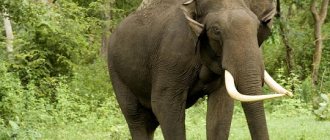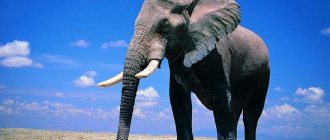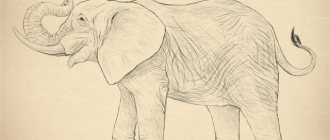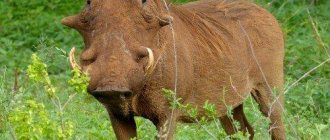Welcome, dear readers, to our website!
Here you can find out many interesting and incendiary stories, many facts and explanations about the world. On our website you will find a lot of useful and interesting information from various fields of science, sports, nature, animals and much more. Read and share with friends!
In this article we will find out how the Indian and African elephants differ.
The elephant is one of the largest representatives of the animal world existing on Earth. Previously, there were many varieties of these giants on our planet. Today, the African elephant and the Indian elephant live among us.
This type of animal included mammoths, which became extinct during the Ice Age, and mastodons, which disappeared before the appearance of people in America, where they lived. The difference between the two remaining species is significant, so it is quite appropriate to make a comparison between the African and Indian elephants.
elephant teeth
In the mouth of these land animals, in addition to the tusks protruding outward, there are four more molars (two each in the upper and lower jaw), consisting of many enamel scales connected to each other and allowing elephants to grind food. The Asian elephant has ribbon-shaped chewing teeth, while the African elephant has diamond-shaped chewing teeth.
Molars are replaced about six times throughout an elephant's life, with new teeth growing behind the old ones.
As for the shape of the tusks, the Indian ones are thin (in females there are no tusks at all). The tusks of the African elephant are thick and huge, and their length sometimes reaches two or more meters.
Body outline
Difference in body outlineElephants are not similar to each other even in body outline - an elephant from Africa has a straight back, sometimes slightly concave. The back of the Asian elephant is clearly convex.
The limbs of an elephant from India are thicker and shorter, so it looks heavier.
The African elephant needs long legs - it eats only the foliage of trees, which it reaches high for. Its counterpart from India also eats some food from the ground, and not just leaves and branches from the tree.
How else is the Indian elephant different from the African one?
The tusks of the largest adult Indian elephant grow to a maximum of one and a half meters in length and weigh 20 - 25 kg. The height of this animal can reach 3 m and weight - 5 tons.
The tusk of an elephant that grew up in northern India is thick and strongly curved, while the tusks of its relatives that settled in southern Africa are thin and sharp, and the further south the territory, the thinner and sharper these formations.
Indian elephants, unlike African ones, live exclusively in the forest, with preference given to undergrowth of bamboo thickets.
African elephants live in both forests and savannas, and are the largest land mammals, as evidenced by an entry in the Guinness Book of Records.
A typical African elephant weighs up to 5 tons, and a female elephant weighs more than 2, but less than 3 tons. The maximum length of an African elephant tusk is 3 m.
The largest representative of this species of elephant was shot in 1974 in Angola. This male weighed more than 12 tons.
Species status
Once upon a time, herds of African elephants reached four hundred individuals. Nowadays, the numbers of all species are rapidly declining and the animals are included in the International Red Book. Both species are on the verge of extinction. Scientists believe that the main reason for this is the destruction of the natural habitat of these giants. They are listed in the Red Book: African in the “Endangered” section, Indian in the “Threatened” section.
No matter how different these huge animals are, we must not forget that they are in dire need of human help. Only he can take measures to save these animals from extinction. Otherwise, one day people will simply lose these smart and powerful helpers.
Amazing details
Elephants do not feel panic at all when meeting a mouse - this is fiction. To blow away such a tiny animal, and with it the nearby stones and other heavy objects, the elephant only needs to exhale.
These giants are truly afraid of ordinary honey bees. Hearing the buzz of an approaching swarm of bees, the elephants immediately take to their heels. But these animals can hardly be called cowardly creatures. They are very careful and smart. By the way, the elephant is included in the list of the most intelligent animals on Earth.
Few people know that the elephant has exceptional hearing, as well as excellent memory and sense of smell. An elephant is able to remember places that are significant to it, as well as people who treated it badly (or well). But the most amazing quality of the elephant is its good ear for music, which allows it to remember and subsequently recognize a melody of three notes. True, he likes low notes much more than high and sonorous ones.
Unlike the rest of the animal kingdom, the elephant seems to have an understanding of death. Elephants are able to identify the corpses (and even bones) of their fellow tribesmen. Researchers were amazed at how the indifference with which elephants treat the remains of other living beings was replaced by a manifestation of care and compassion towards the corpses of their relatives.
Having seen the skeleton of an elephant, these animals cannot pass by: they begin to intensely feel the remains with their trunks, paying special attention to the head of the deceased. Having thoroughly probed the skull with their trunks, as if trying to identify their untimely departed friend, the elephants do not throw his lifeless body to be torn apart by scavenger animals, but cover it with dry leaves.
When one of the members of the herd is mortally wounded, healthy elephants, as if seeing off a relative to a better world, stand vigil around him and do not leave until the very end...
Behavior
The African elephant and the Indian elephant differ in their disposition. Representatives of the Indian species are more friendly towards people, and it is not difficult to tame them. It is them that residents of Asian countries use to perform heavy physical work, for example, when transporting large, heavy items. And in the circus, Indian elephants often demonstrate their skills to us.
The African elephant quite often shows aggression and it takes a lot of effort to train it, although this task cannot be called impossible.
These mammals are distinguished by a language of communication that is completely understandable to humans. When an animal is “not in the mood” or is aggressive, it spreads its ears. For defense, tusks, trunk and powerful legs are used. When an elephant senses danger or is frightened by something, it squeals and runs away, destroying everything in its path.
Why does an elephant need tusks?
With the help of this “tool” the elephant uproots trees and sometimes defends itself from enemies, the main of which is man. A maddened elephant with tusks (photo below) that are sometimes as long as its own height poses a serious danger to both its fellows and humans, but rabid elephants are a rare occurrence. Elephant tusks are more of a punishment from nature than a gift. The fate of African elephants, whose tusks have always been highly valued, is especially sad.
With the arrival of a white man with a gun on the “dark” continent, Africa ceased to be an “elephant’s paradise.” Ruthlessly exterminating good-natured giants for the sake of precious tusks, European poachers left their carcasses to be devoured by hyenas and vultures.
Where is the elephant cemetery?
Interesting fact: no one has ever found the tusks of dead African elephants. This circumstance formed the basis of numerous legends that the inventive local population never tires of inventing. The most notorious smugglers were already ready to believe in the existence of mysterious elephant cemeteries... but then wildlife researchers got down to business.
According to information provided by 20th century naturalists, elephant tusks serve as a source of minerals for porcupines, which are completely deprived of the minerals contained in the soil with the arrival of the rainy season.
The question of the disappearance of tusks remained open for a long time for the reason that porcupines are nocturnal animals.
How to distinguish an elephant tusk from a fake made of another material
Experts working with antiques note that very often the role of elephant tusks is given to high-quality plastic or ceramic fakes that look very similar to carved ivory. Some counterfeiters pass off synthetic materials filled with bone chips as elephant tusks, which are also difficult to distinguish from natural material.
To make fakes, in most cases, casting and hand-painting methods are used. If you look at the work of counterfeiters with the naked eye, you can detect seam lines and marks from sprues. But the main difference is considered to be the unnatural smoothness and lightness of non-natural products.
Other, cheaper bones are often passed off as elephant tusks, but the reason is not always the high cost of the natural material. It’s just that often sellers, being essentially resellers, do not themselves know what they are selling.
There are also frequent cases when items made from the bones of their ancient ancestor, the mammoth, were passed off as items made from elephant ivory. By the way, it is prohibited not only for transportation, but also for processing.
The Thai authorities decided to undertake an interesting experiment in March 2015 by legalizing the possession of ivory. The population was asked to register the tusks of elephants and mammoths illegally stored in their homes, in order to turn from smugglers into law-abiding citizens.
As it turned out, almost all residents of the country keep ivory souvenirs. Those of them who decided to register their treasures, as promised, were released by the state from liability for illegal possession of contraband goods.
As it turned out, in many families, products made from ivory and mammoth ivory played the role of heirlooms and were kept for posterity. Now owners of family valuables can rest easy.
Thai citizens who do not respond to the authorities' call face a fine of $200,000 or 3 years in prison.
How do mammoth tusks differ from elephant tusks?
They have no voids. Having a solid, uniform texture, they delight the eye with a variety of colors (from pale cream to deep black) and pronounced chiaroscuro.
The cross section of mammoth tusks has a heterogeneous color, reminiscent of alternating dark and light rings dotted with radial or circular cracks. The white color of the tusk and tiny texture are characteristic signs of low-quality material.
The main feature by which one can determine that the “elephant tusk” actually belonged to a mammoth is a “mesh” pattern that opens when cross-sawed. The mesh is formed by interlacing of thin grooves and nerve fibers.
There are up to half a million African elephants in the world; Asian elephants are about 10 times smaller. As you know, elephants are large and very intelligent animals, which have served humans for peaceful and military purposes since ancient times.
Evolution
In terms of their genetic characteristics, the African savanna elephant and the African forest elephant are closest to each other, which for a long time were even considered the same species. But scientists were able to find out that these species separated about 2-5 million years ago and for more than 500 thousand years their populations practically did not interbreed. But Asian elephants are closer to extinct mammoths than to their African counterparts. The Asian elephant is currently divided into several subspecies that live in isolated populations. These are Indian, Sumatran, Sri Lankan and Bornean elephants.
Giants
Elephants are the most gigantic land animals on Earth. Their average weight reaches five tons, and their body length is 6-7 meters. In 1956, an elephant weighing 11 tons was killed in Angola.
A female elephant carries a baby for 22 months, the newborn weighs 120 kilograms.
The brain of an elephant weighs 5 kilograms, the heart - 20-30 kilograms. It beats at a frequency of 30 beats per minute.
To feed such a “colossus”, an elephant has to look for food and eat most of the day, at least 20 hours. An elephant eats from 45 to 450 kilograms of plant food per day and drinks from 100 to 300 liters of water.
Elephants live 50-70 years. But there are also reporters. War elephant (served in the Chinese army) Lin Wang from Taiwan died in 2003 at the age of 86.
How elephants reproduce and give birth
Pregnancy lasts from 18 to 22 months. Towards the end of the term, the mother will choose a female from the herd as an “auntie” who helps with the birth and raising of the offspring. Twins are rarely born.
Little elephants
The young are breastfed until they are four years old, although they develop an interest in solid foods from six months. The entire family group protects and raises the cub. In early adolescence, elephants become sexually mature, and from the age of 16 the female gives birth. A mother elephant rarely gives birth to more than 4 calves during her life. Between the ages of 25 and 40, elephants are in their prime and reach the peak of their physical strength. At about 55, old age begins, and with luck, they will live to 70 and perhaps even longer.
Smarties
Aristotle wrote: “The elephant is an animal that surpasses all others in wit and intelligence.” Elephants really have a very good memory and developed intelligence. Elephants also turned out to be capable of learning human language.
An elephant named Kaushik, living in Asia, has learned to imitate human speech, or rather, five words: annyong (hello), anja (sit), aniya (no), nuo (lie down) and choah (good).
Kaushik not only mindlessly repeats them, but, according to observers, understands their meaning, since these are either commands that he carries out, or words of encouragement and disapproval.
Communication
Elephants usually communicate using infrasound, so for a long time the elephant language remained unsolved. Research by Christian Herbst of the University of Vienna on the larynx of a dead elephant showed that elephants use their vocal cords to communicate.
The “vocabulary” of the elephant language turned out to be quite rich - Herbst recorded about 470 different stable signals that elephants use.
They can use them to communicate with each other over long distances, warn of danger, report births, and use various addresses to members of the herd, depending on their position in the hierarchy.
Tusks
Elephants, like people, can be left-handed or right-handed. Depending on which tusk the elephant works more, one of them becomes smaller.
Over the past century and a half, the average length of elephant tusks in both Africa and India has halved.
This is due to the fact that the largest representatives of the population become victims of poachers, and the length of the tusks is a genetically inherited trait.
The tusks of deceased elephants are extremely rare to find. Because of this, for a long time there was an opinion that elephants go to die in mysterious elephant cemeteries. Only in the last century it was discovered that porcupines eat tusks, thus compensating for mineral hunger.
Enemies of elephants in nature
It is believed that elephants have no natural enemies. However, this does not mean that they are safe in the wild. Elephants are prey for lions and tigers. As a rule, weak or young elephants become their victims. Since elephants form close-knit herds, the hunting animals have to wait until someone falls behind the others. For the most part, elephants are healthy, so they don't often become food.
From time to time, carnivores, when there is nothing to eat, become bolder and hunt slow young elephants. Since elephant herds do not hide from meat eaters, this makes them an attractive target. Predators know that adult elephants will kill them if they are not careful, but if they are hungry enough, they will take the risk.
Since elephants spend a lot of time in the water, baby elephants become prey to crocodiles. It's not often that the unspoken law of nature - don't mess with elephants - is violated. The mother elephant closely monitors the baby, and other females in the herd also watch the babies. The consequences for predators when they attack young animals are immediate.
Hyenas circle elephants when they recognize signs that someone is sick or old enough to fight back. They feed on elephants after the death of the giants.
Taming the Elephants
Elephants, although intelligent animals, can also be dangerous. Male elephants periodically go through a state of so-called “must”. At this time, the level of testosterone in the blood of animals is 60 times higher than normal.
In order to achieve balance and obedience in elephants, they begin to be trained from early childhood.
One of the most effective methods is this: the baby elephant’s leg is tied to a tree trunk. Gradually he gets used to the fact that it is impossible to free himself from this state. When the animal grows up, it is enough to tie it to a young tree, and the elephant will not try to free itself.
Description of the elephant (appearance)
These animals have a lobed forehead and a prominent, dome-shaped, double crown.
Brain
Elephants have the largest brain of any land mammal, 3 or 4 times larger than that of humans, although lighter in body proportions.
Organs of vision
The eyes are small. Due to their position and the size of their head and neck, they have limited peripheral vision with a range of only 8 meters.
Ears
Ears with large veins under a thin layer of skin cool the blood and control body temperature (elephants do not sweat). From age 10, the top of the ear gradually bends, increasing by about 3 cm for every 20 years of an elephant's life, which gives an indication of the animal's age. Elephants have excellent hearing and can detect sounds at a distance of 15 km!
Teeth
Nature gave elephants six sets of teeth for life, with old teeth being replaced with new ones as they wear out. After all the teeth are used up, the elephant cannot feed itself and dies.
Tongue and taste
Elephants have big tongues and they love to be petted! Animals have a developed sense of taste and are picky about what they eat.
Trunk
An elephant's trunk is one of nature's most amazing creations. It is made up of six major muscle groups and 100,000 individual muscle units. At the tip of the Asian elephant's trunk there is one finger-like process, while African elephants have two. The trunk is dexterous and sensitive, strong and powerful.
The elephant uses its trunk for many purposes:
- picks flowers;
- picks up a coin, huge logs or a baby elephant;
- reaches high branches;
- explores the forest floor;
- delivers food and water to the mouth;
- splashes out huge volumes of liquid with great force;
- makes trumpet sounds.
As a weapon of self-defense, the trunk is a formidable weapon capable of killing. The trunk is used for the sense of smell, which is more developed in elephants than in other land animals. A damaged trunk is a death sentence for an elephant. Elephants handle their trunk carefully, protect it, sleep tucked under their chin, and hide it there when threatened.
Tusks
The tusks are the developed upper incisors. They are used for:
- digging the earth in search of water;
- balancing large objects;
- protection from predators.
Not all males are endowed by nature with tusks. Males are not at a loss without them. The energy that they do not spend on growing tusks increases their body weight, and they have stronger and more developed trunks.
Leather
Elephants are called thick-skinned, but they are not rough, but sensitive creatures. The skin is heavily grooved, hangs down in folds, is covered with coarse bristles, and is irritated by the bites of arthropods and mites that have settled in the folds. Regular bathing is important for animal health. Elephants cover themselves with mud with their trunks, protecting their bodies from biting creatures.
Tail
The elephant's tail is up to 1.3 m long and has coarse, wire-like hairs at the tip, and the animals use this organ against insects.
Legs
The elephant stupas are amazing. Heavy animals easily overcome wet areas of land and swamps. The foot expands, the pressure decreases. The foot compresses, the pressure on the surface increases, which allows the greater mass of the elephant to be evenly distributed.
Funeral rite
Elephants not only have high levels of intelligence, but also sensitive hearts. When someone from an elephant family dies, his relatives lift him up with their trunks, loudly turbulate him, and then roll him to a depression and cover him with branches and throw earth at him. Then the elephants sit silently next to the body for several more days.
There are also cases where elephants also try to bury people, sometimes mistaking sleeping people for dead.
Everyone on our planet, without exception, knows what an elephant looks like. But not everyone can correctly tell and explain why he needs such an organ as a trunk. Let's first find out what a trunk is and what it looks like. Some people say that the trunk is some kind of nose. And some people think that the trunk is a hand. But all these people are right, and the trunk has many functions.
Firstly, it is considered an organ of smell, like the nose in humans. An elephant will be able to smell different smells from a great distance if it turns its trunk to the side.
Secondly, the trunk can serve as an animal's lip when it obtains food and then puts it in its mouth. The trunk can also be the tool with which an elephant plucks leaves from trees and even draws water when it is hot and thirsty. That is, the trunk can also serve as a hand. And if an elephant is suddenly bitten by midges, it can scratch itself with its trunk or drive away the annoying insects.
From time to time, the elephant uses its trunk to fight enemies. His blow can be so powerful that it will cripple the offender or even lead to his death. In ancient times, colonialists from England used elephants as labor for a very long time. Thanks to the properties of its trunk, it can carry things with heavy weight, clear roads in sparsely populated areas and cut down trees. During the mating season, the elephant is required to use its trunk, because this is the only way male elephants can get the attention of a female. But even more importantly, with the help of the roar emitted by the trunk, these animals can communicate with their relatives and convey messages to them. From this list of functions of the trunk, you can already understand that this organ is indispensable for elephants.
Scientists have learned that the trunk used to be a lip, which over time merged with the nose. And now the trunk is a very mobile and powerful muscular tube. Just as all humans have a nose that is divided by a nasal septum, so an elephant has two openings in its trunk. At its end there are very small, but strong and trained muscles that serve as the elephant’s fingers. You know that elephants descended from mammoths? If yes, then you should know that mammoths had tusks. Elephants also have them, although they have changed a little. They are also located in the upper jaw, like in mammoths.
Why does an elephant need tusks?
The tusks themselves are just upper teeth, but grown to an incredible size. Although these are ordinary teeth, they are of great importance in the life of all elephants. Female elephants do not have the massive tusks that elephants can display. In males they are longer and thicker. During the mating season, elephants compete with each other for the ability to procreate with a particular female elephant. In these cases, the tusks act as dangerous weapons. Elephants also often use tusks to ensure the safety of their family and offspring from formidable predators, because not every tiger or lion will decide to fight an elephant or elephant, because there is a risk of being killed with one blow.
To the question Do elephants have tusks? given by the author Boris
the best answer is that
Indian elephants do not have tusks, and if they do, they are not visible from the outside.
Males have tusks about a meter and a half long. One third of an elephant's tusk is hidden in the body under the skull. Nowadays there are no elephants with huge tusks, since all individuals with such tusks were killed by hunters centuries ago, and the length of the tusks is a genetically inherited trait. Nowadays you rarely see an elephant with tusks that are even half the size of those of its predecessors. An elephant's tusks grow throughout its life and are an indicator of its age. Elephants are “right-handed” and “left-handed” because they adapt to working with their right or left tusk. Thus, one tusk is shorter than the other because it wears out faster. Elephants' tusks can be not only of different sizes, but also of different shapes, and can also grow sideways - scientists distinguish elephants by their tusks and the shape of their ears. African elephants have tusks, although they are smaller than those of males. The tusks of males can be huge - the record was 4.1 m (they weighed 148 kg). The length and weight of the tusks do not always correspond to each other: the heaviest tusks were those of an elephant killed in 1898 near Kilimanjaro - 225 kg. in both canines. Asian elephant (Elephas maximus). The weight of males is 5-6 tons, females up to 4 tons, shoulder height is 2.5-3 meters. Tusks, modified upper incisors, are large in size only in males. Among male Asian elephants, individuals without tusks are quite common. Source: Answer from Yergey Sapunov
[guru] nah ukn
Answer from Dmitry Chagin
[guru] No.
Answer from Natalia Pozdnyakova
[guru] Only in males.
Reply from Simply Leo
[guru] elephants have something else
Reply from Ved68
[guru] For women this is called. - rolling pins!
Answer from Goryacheva Ekaterina
[guru] elephants have them too
Reply from User deleted
[active] It seems like NO, but come on, regardless of whether I answered correctly, will my answer still be the best? Let's? Oh please! =)
Answer from Yomutin Yan
[active] Elephants have them.
Reply from Natasha
[guru] On September 26, British dentists removed the tusk of the African elephant Flora from the Moscow Zoo. This was reported by the press service of the capital's menagerie. Former circus star Flora moved into the zoo last fall with a broken tusk. “Caries began to develop on its remains, which led to a strong inflammatory process,” said zoo veterinarians. For the operation, the zoo invited four specialists from the UK, led by a dentist. Instead of a drilling machine, he used hammers and a chisel, “which terrified ordinary people,” zoo employees shared their impressions. However, veterinarians noted that the elephant only needed a small dose of a potent painkiller. The total weight of the equipment delivered from the UK was about 500 kilograms. The operation took place over 3 hours. Flora is now feeling well, veterinarians note. As expected after visiting the dentist, she was ordered to fast for an hour.
Site search
Let's get acquainted
Kingdom: Animals
Read all articles Kingdom: Animals
Elephants (lat. Elephantidae) are a family of mammals of the order Proboscis. Of the extant species, the family includes three species of elephants, belonging to two genera.
African elephants (Loxodonta)
Savannah elephant (Loxodonta africana)
Forest elephant (Loxodonta cyclotis)
Indian elephants (Elephas)
Asian elephant (Elephas maximus)
Indian elephant.
Despite the seemingly almost one hundred percent similarity in appearance, African and Indian elephants have a lot of differences. African (savannah) elephants are larger than Indian ones - at the highest point of the body (at the shoulders) they can reach 3.7 meters, and their weight exceeds 6-7 tons. Indian elephants are smaller than savanna elephants, but larger than forest elephants - they weigh about 5 tons and grow up to 3.5 meters.
The ears of African elephants are very large, their shape resembles the outlines of the “black” continent, and the vein pattern is individual, like human fingerprints.
African elephant.
Long, strong tusks adorn the heads of not only males (like Indian elephants), but also females. One third of an elephant's tusk is hidden in the body under the skull. An elephant's tusks grow throughout its life and are an indicator of its age.
Elephants are either “right-handed” or “left-handed” because they adapt to use their right or left tusk. Thus, one tusk is shorter than the other because it wears out faster. Elephants' tusks can be not only of different sizes, but also of different shapes, and can also grow sideways - scientists distinguish elephants by their tusks and the shape of their ears.
In addition to tusks, elephants have four more molars, each of which weighs about 2.3 kilograms and is the size of a brick. During their life, elephants completely replace their entire set of molars six times. As elephants age, their teeth become too sensitive, and they move to the swamps in search of softer vegetation. Here they remain until the end of their lives, becoming the involuntary source of many legends that elderly elephants go to die in some mysterious “valleys of death.”
In the 20th century, hunter John Hunter managed to establish where the tusks disappear - it turned out that African porcupines eat them, thus trying to satisfy their mineral hunger.
The trunk is a long flexible process formed by the nose and upper lip fused together. The usual length of the trunk is about 1.5 m, weight - 135 kg. The elephant's trunk is controlled by more than 40 thousand muscles, so it is equally masterful in lifting a heavy log and a straw. At the end of the trunk of the African elephant there are two finger-like outgrowths adapted for comfortable grip; the Indian elephant has only one such “finger”.
In the center of the elephant's foot there is a pad of fat, which, each time the elephant lowers its foot, “flattens”, increasing the area of support. Elephants step on their toes, which they use to feel the road, after which they step on the soft part of the foot. The pad on the foot absorbs sound - this helps elephants move silently.
On average, elephants live 70 years. Every female elephant is a mother four to five times over the course of 50-70 years. Pregnancy in elephants lasts 21-23. or even 25 months. Elephants give birth and feed their calves while standing.
Both Indian and African elephants live in groups united by family kinship. The herd is led by the oldest and most experienced female, on whose decisions the entire life activity of the group depends - she determines when it is time for lunch, rest or a change of habitat.
The permanent presence of adult males in the herd is completely excluded - they leave the family at the age of 12-13 years, leading a solitary lifestyle or teaming up with similar loners, and visit female elephants only during the mating period, without taking any part in the further raising of the offspring. Groups living in the neighborhood are often also related and greet each other joyfully when meeting on the banks of bodies of water.
Reproduction can occur at any time of the year, regardless of the season. Females are in estrus for only 2-4 days; A complete estrous cycle lasts about 4 months. Males join the herd after mating matches - as a result, only mature dominant males are allowed to breed. Fights sometimes lead to serious injuries to opponents and even death.
Elephants usually move at a speed of 2-6 km/h, but for a short time they can reach speeds of up to 35-40 km/h.
Elephants can swim very long distances. There is a known case when 79 elephants crossed the multi-branch Ganges delta in India. At the same time, they swam continuously for six hours and, after a short respite on a sandbank, for another three hours, through the next branch.
Elephants sleep standing up, gathered together in a dense group; only the cubs lie on their sides on the ground.
Elephants are thick-skinned animals, in the truest sense of the word - in some places the thickness of their skin can reach 3.5-4 centimeters. However, this does not prevent her from remaining extremely sensitive, sensing the presence of even the smallest insects. To protect themselves from their stinging bites or to cool off, elephants douse themselves with water and roll in the mud or dust.
It is believed that elephants are afraid of mice: a mouse can get into its trunk and the elephant will suffocate. Slander of envious people! Elephants are absolutely not afraid of mice. At the zoo, gray animals run around in an elephant's stall, but the giant doesn't even use his ears, although he has a keen sense of smell and excellent hearing. And if the mouse plucks up courage and climbs into its trunk, the elephant can, after taking in air, “shoot” it out of the cage - it doesn’t seem like much.
Elephants' most developed sense is smell, but sounds play the most important role in their communication. The flapping of ears warns of danger, calling to stand in a circle and protect the smallest and weakest, the stomping of feet and many variations of sounds also carry certain information for those who are at a distance of up to 8 kilometers. And even such an unpleasant phenomenon for humans as rumbling in the stomach is very welcome in the elephant community - everyone who hears it knows that everything around is calm. Elephants have an ear for music and musical memory, they are able to distinguish melodies of three notes; they prefer violin music and low sounds of bass and horns to high flute melodies.
In one day, an elephant consumes about 300 kg of leaves and grass containing a high percentage of moisture. This applies to free-living elephants. In captivity, an adult elephant eats about 30 kg of hay, 10 kg of vegetables, 10 kg of bread. Depending on the air temperature, an elephant drinks from 100 to 300 liters of water in one day.
Elephant trainers tame their huge charges in a cunning way from a young age. When the baby elephant is still quite young and small, one of his legs is tied to the trunk of some tree, unable to free himself from this captivity; over time, the elephant believes that this is completely impossible. And when he grows up and becomes many times stronger and larger, then it is enough to tie him to a young tree even with a not very strong rope and the elephant will not even try to free himself.
When copying materials in full or in part, a valid link to the UkhtaZoo website is required.
Unusual animal friendship (photos and videos)
2021-11-08 03:07:33
Corn porridge with milk
2021-09-29 03:58:57
Five-minute marinated lard with garlic and spices
2021-09-29 03:58:57
Life in the herd
Elephants live in close social groups called herds, usually consisting of females and their offspring. The main leader of the herd is the most experienced and mature female, so matriarchy reigns in the elephant family. The leader of the herd remembers how to find the way to food and water, while avoiding predators, and knows the best places to hide. Also, the main female has the right to teach younger individuals the rules of behavior in society. In some cases, the group may consist of one of the main leader's sisters and her offspring. When the number of individuals in a group becomes large, a new herd is formed, and they can maintain free communication with other associations.
Adult males do not usually live in a herd. After gaining independence from their mother, males leave the herd and live alone or with other bachelors. Males can visit a herd of females only for a short time, for reproduction. They do not participate in raising their offspring.
Etiquette is an important component of elephant society. The trunk may be extended to another elephant as a greeting, to show affection, to hug, during wrestling, and to check reproductive status.











